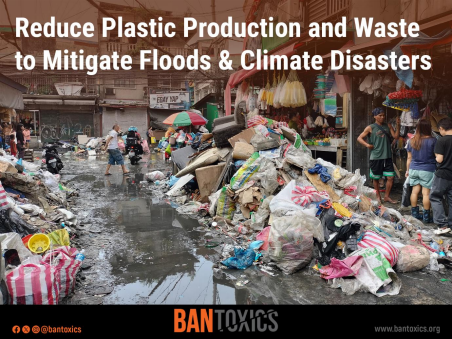“It has always been easy to blame trash and the lack of discipline for recent and future flooding, yet the climate impacts of unhampered plastic production, along with land use conversion, large-scale mining, and their contribution to environmental degradation are being overlooked.” This was the statement of environmental justice organization BAN Toxics, after millions of Filipino people suffered from Typhoon Carina (Gaemi).
“The President must realize that 99% of all plastics are derived from fossil fuels, the largest contributor to the global climate crisis. The exponential increase in plastic production is expected to exacerbate the so-called ‘triple crisis’ of climate change, biodiversity loss, and pollution,” Jam Lorenzo, head of BAN Toxics’ Policy Development and Research, said.
“The import of finished plastic products and wastes into the country, combined with the current rate of domestic plastic production and other factors, is overwhelming the capacity of our waste management systems, rendering them ineffective,” Lorenzo said.
In 2021, the Philippines, imported 1.98 million tonnes of plastic raw materials, plastic products, and plastic packaging with 393 kilo tonnes export, making it a net importer of plastics. The country had a virgin resin production capacity of 900 kilo tonnes in 2019, with projections of at least an additional 360 kilo tonnes from 2021 onwards.
“With only 9% of consumed plastics being recycled and 33% disposed of in landfills, an estimated 35% – or about 1 million tons of plastic waste in 2021 – leak into the open environment. This amount is equivalent to the average weight of 714,285 sedan vehicles, more than the total number of registered vehicles in Metro Manila. These figures do not include the import of hazardous plastic wastes, both legal and illegal into the country. Adding to this point, it is also important to note that countries such as the Philippines have historically been on the receiving end of significant amounts of illegal waste imports from developed countries.”

“The Extended Producers Responsibility (EPR) law has so far been failing to compel multinational corporations to take immediate action to phase out single-use plastics, as evidenced by brand waste audits in the country. Many of the companies that topped the list have previously been identified as top plastic polluters in global brand audits.”
The group references multiple studies that highlight the significant growth in plastic production over the last decade, estimated to double or even triple by 2050. Greenhouse gas (GHG) emissions from plastic could reach over 56 gigatons or 10-13% of the entire remaining carbon budget, based on a study in 2019. These conservative estimates are complemented and updated by newer studies. Recently published report from the Lawrence Berkeley National Laboratory revealed that the global plastic production
generated 5.3% of total global GHG emissions (excluding agriculture, land use and forestry) in 2019.
“We stand with the Filipino people in holding the government accountable for the recent floods and those yet to come, and we call for science-informed and human rights-based climate actions. We urge policymakers to prioritize control measures in its policy mix for plastic production, manufacturing, and importation, especially for the most problematic, non-essential plastics, and those containing known hazardous chemicals. Addressing plastic pollution requires upstream approaches – focusing on pre-consumption and the reduction of production – to mitigate its impact on livelihoods, human health, and the environment.

The group also cautions against using incineration as a solution for plastic wastes. “Scientific studies by the Center for International Environmental Law (CIEL) and Break Free From Plastic (BFFP) highlight that incineration of plastic could produce more than 850 million metric tons of greenhouse gasses – equivalent to the emissions from 189 five-hundred-megawatt coal power plants. The idea of clean incineration technologies in the country seems like a pipe dream, considering that less than half of the country’s barangays have materials recovery facilities and that several LGUs are unable to address current challenges in the management of wastes such as proper segregation and collection.”
Climate Fund
As the country hosts the Loss and Damage Fund, BAN Toxics emphasizes that “it presents both an opportunity and a challenge for the Marcos Jr. administration. It is a chance for the administration to be a genuine advocate for climate-vulnerable countries and to lead in making the Fund truly impactful for developing countries,” according to Lorenzo. The Fund, a financial mechanism developed to assist vulnerable nations in recovering from climate-related impacts, was established at the COP 27 UN Climate Change Conference in 2022.
It aired concerns, however, over the involvement of the Global North in managing the Loss and Damage Fund, particularly with the World Bank serving as the financial intermediary. “We want this Fund to be truly accessible to developing countries, without conditionalities that advance the policy agenda of wealthy nations. This is important for Southeast Asian countries, which are often used as dumping grounds for plastic waste by richer countries, including the United States.”
“As a remedy to the disproportionate and historic contribution of wealthy nations to the climate crisis, the Fund must not be used as a scapegoat. These polluting countries need to make a significant move to address the major drivers of the crisis, including taking the lead in phasing out fossil fuels,” the group said. #
References:
https://www.ciel.org/wp-content/uploads/2019/05/Plastic-and-Climate-FINAL-2019.pdf
https://escholarship.org/uc/item/12s624vf
https://sustainability.ph/solutions/intelligence/plastic-recycling-in-the-philippines










